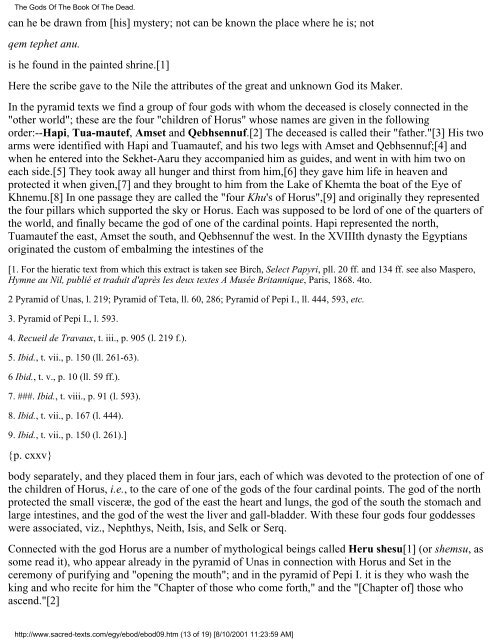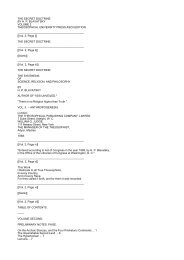Create successful ePaper yourself
Turn your PDF publications into a flip-book with our unique Google optimized e-Paper software.
The Gods Of The <strong>Book</strong> Of The <strong>Dead</strong>.<br />
can he be drawn from [his] mystery; not can be known <strong>the</strong> place where he is; not<br />
qem tephet anu.<br />
is he found in <strong>the</strong> painted shrine.[1]<br />
Here <strong>the</strong> scribe gave to <strong>the</strong> Nile <strong>the</strong> attributes <strong>of</strong> <strong>the</strong> great and unknown God its Maker.<br />
In <strong>the</strong> pyramid texts we find a group <strong>of</strong> four gods with whom <strong>the</strong> deceased is closely connected in <strong>the</strong><br />
"o<strong>the</strong>r world"; <strong>the</strong>se are <strong>the</strong> four "children <strong>of</strong> Horus" whose names are given in <strong>the</strong> following<br />
order:--Hapi, Tua-mautef, Amset and Qebhsennuf.[2] The deceased is called <strong>the</strong>ir "fa<strong>the</strong>r."[3] His two<br />
arms were identified with Hapi and Tuamautef, and his two legs with Amset and Qebhsennuf;[4] and<br />
when he entered into <strong>the</strong> Sekhet-Aaru <strong>the</strong>y accompanied him as guides, and went in with him two on<br />
each side.[5] They took away all hunger and thirst from him,[6] <strong>the</strong>y gave him life in heaven and<br />
protected it when given,[7] and <strong>the</strong>y brought to him from <strong>the</strong> Lake <strong>of</strong> Khemta <strong>the</strong> boat <strong>of</strong> <strong>the</strong> Eye <strong>of</strong><br />
Khnemu.[8] In one passage <strong>the</strong>y are called <strong>the</strong> "four Khu's <strong>of</strong> Horus",[9] and originally <strong>the</strong>y represented<br />
<strong>the</strong> four pillars which supported <strong>the</strong> sky or Horus. Each was supposed to be lord <strong>of</strong> one <strong>of</strong> <strong>the</strong> quarters <strong>of</strong><br />
<strong>the</strong> world, and finally became <strong>the</strong> god <strong>of</strong> one <strong>of</strong> <strong>the</strong> cardinal points. Hapi represented <strong>the</strong> north,<br />
Tuamautef <strong>the</strong> east, Amset <strong>the</strong> south, and Qebhsennuf <strong>the</strong> west. In <strong>the</strong> XVIIIth dynasty <strong>the</strong> Egyptians<br />
originated <strong>the</strong> custom <strong>of</strong> embalming <strong>the</strong> intestines <strong>of</strong> <strong>the</strong><br />
[1. For <strong>the</strong> hieratic text from which this extract is taken see Birch, Select Papyri, pll. 20 ff. and 134 ff. see also Maspero,<br />
Hymne au Nil, publié et traduit d'après les deux textes A Musée Britannique, Paris, 1868. 4to.<br />
2 Pyramid <strong>of</strong> Unas, l. 219; Pyramid <strong>of</strong> Teta, ll. 60, 286; Pyramid <strong>of</strong> Pepi I., ll. 444, 593, etc.<br />
3. Pyramid <strong>of</strong> Pepi I., l. 593.<br />
4. Recueil de Travaux, t. iii., p. 905 (l. 219 f.).<br />
5. Ibid., t. vii., p. 150 (ll. 261-63).<br />
6 Ibid., t. v., p. 10 (ll. 59 ff.).<br />
7. ###. Ibid., t. viii., p. 91 (l. 593).<br />
8. Ibid., t. vii., p. 167 (l. 444).<br />
9. Ibid., t. vii., p. 150 (l. 261).]<br />
{p. cxxv}<br />
body separately, and <strong>the</strong>y placed <strong>the</strong>m in four jars, each <strong>of</strong> which was devoted to <strong>the</strong> protection <strong>of</strong> one <strong>of</strong><br />
<strong>the</strong> children <strong>of</strong> Horus, i.e., to <strong>the</strong> care <strong>of</strong> one <strong>of</strong> <strong>the</strong> gods <strong>of</strong> <strong>the</strong> four cardinal points. The god <strong>of</strong> <strong>the</strong> north<br />
protected <strong>the</strong> small visceræ, <strong>the</strong> god <strong>of</strong> <strong>the</strong> east <strong>the</strong> heart and lungs, <strong>the</strong> god <strong>of</strong> <strong>the</strong> south <strong>the</strong> stomach and<br />
large intestines, and <strong>the</strong> god <strong>of</strong> <strong>the</strong> west <strong>the</strong> liver and gall-bladder. With <strong>the</strong>se four gods four goddesses<br />
were associated, viz., Nephthys, Neith, Isis, and Selk or Serq.<br />
Connected with <strong>the</strong> god Horus are a number <strong>of</strong> mythological beings called Heru shesu[1] (or shemsu, as<br />
some read it), who appear already in <strong>the</strong> pyramid <strong>of</strong> Unas in connection with Horus and Set in <strong>the</strong><br />
ceremony <strong>of</strong> purifying and "opening <strong>the</strong> mouth"; and in <strong>the</strong> pyramid <strong>of</strong> Pepi I. it is <strong>the</strong>y who wash <strong>the</strong><br />
king and who recite for him <strong>the</strong> "Chapter <strong>of</strong> those who come forth," and <strong>the</strong> "[Chapter <strong>of</strong>] those who<br />
ascend."[2]<br />
http://www.sacred-texts.com/egy/ebod/ebod09.htm (13 <strong>of</strong> 19) [8/10/2001 11:23:59 AM]

















